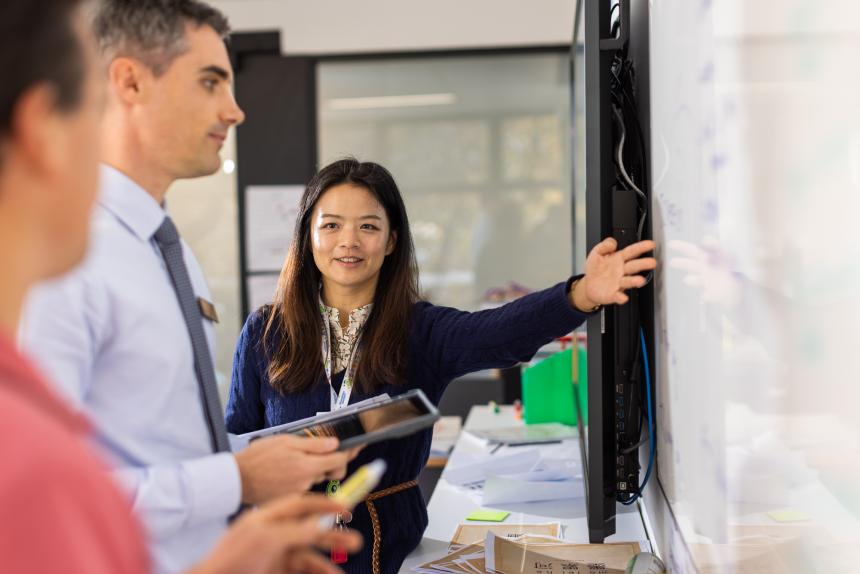
The use of research in schools is a surprisingly under-researched topic in Australia. While there is a lot of discussion about the quality of research evidence, there is far less discussion about what constitutes quality use of research evidence in schools.
To increase knowledge about the practice of research evidence use in Australian schools, Evidence for Learning (E4L) led a research investigation, Getting Evidence Moving in Schools (GEMS), to explore what educators and schools do when they work with professional learning providers who help them to engage with research evidence.
Beyond finding ‘the right’ evidence
It is a common misconception that in order to use research evidence in their work, an educator just needs to find the right piece of research to tell them what to do in their classroom.
Usually, the perfect piece of research evidence does not exist. Instead, educators need to identify, understand, interpret and apply evidence from research to their classroom practice.
In GEMS, educators were observed going through different stages during the process of using research evidence. These included: selecting a focus area, identifying specific research evidence to support the focus area, and understanding and applying research evidence to their practice (see Figure 1).
Figure 1: Some of the interactive stages and educator roles involved in using evidence from GEMS
| Selecting focus areas | Identifying specific research to support focus areas | Understanding and using the research |
|---|---|---|
| School leaders analyse whole school data | School leaders source research | School leaders provide instructional leadership to assist with understanding, planning for, carrying out and monitoring research use |
| Teachers discuss areas for improvement | Teachers source research | Teachers use strategies to unpack research, adapt it to their context, create lesson plans or resources, change or reinforce their classroom practice and reflect on research use |
These stages did not always follow a particular order. Sometimes educators needed to understand what research evidence existed in order to select a focus area. Others worked on multiple, overlapping focus areas at once. Regardless of the order, the investigation observed that engaging with research evidence often involved multiple stakeholders from schools, professional learning providers and the research community.
Key enablers
GEMS participants identified several enablers that help them to use research evidence, including:
- guidance in finding relevant, high-quality research and adapting it to the school or classroom
- regular, job-embedded meeting times for collaboration on research use
- support from and discussion with colleagues
- support from school leaders and mid-level leaders such as support to try new classroom practices
- external expertise of professional learning providers to support structures, processes and tools.
Insights
GEMS insights suggest that, for research evidence to become part of everyday practice, educators need to be actively and deliberately involved in understanding and applying it; interact with others as part of the process; and be supported in determining which evidence is relevant and high-quality. In other words, even when there is support from professional learning providers, the process is still active, social and demanding for educators.
The Australian research on understanding and applying research evidence to teaching practice is limited. Insights from GEMS are based on a review of the global and Australian literature and a recent study of evidence use in Australian schools. These insights offer suggestions for what might work in schools based on interpretation of the available evidence. But there is much more to learn. This is why it is important for organisations like the Australian Education Research Organisation (AERO) and E4L and projects such as Monash University’s Q Project to continue to examine how evidence is used in schools, and how we can encourage its adoption and effective implementation.
Where next
You can find out more about the use of research evidence and read the GEMS Insights Paper on the E4L website.
About GEMS
GEMS is a 3-year investigation involving 205 educators across 24 primary schools in New South Wales and Victoria. It supported the development of evidence-based resources on key topics in literacy and numeracy, and then investigated how educators work with providers to use research evidence on literacy and numeracy teaching strategies.
GEMS is led by E4L in collaboration with the Centre for Evidence and Implementation (CEI), Monash University Faculty of Education, professional learning providers Teaching Sprints, EdPartnerships International and Training 24/7, and the education departments in New South Wales and Victoria.
About the author
Danielle Toon, Co-Director of Evidence for Learning (E4L)
Danielle is responsible for E4L‘s strategy, products, projects and partnerships. She established E4L’s Early Childhood Education initiative and leads the GEMS collaborative research project on evidence mobilisation in schools.
Danielle has 20 years’ experience in strategy, policy, research, design and implementation projects for schools, early learning providers, for-purpose organisations, education systems and large corporations. Danielle was a consulting expert to an Organisation for Economic Co-operation and Development (OECD) study on teacher preparation, and in recent years managed a global project on teacher training for Learning First in partnership with the Bill & Melinda Gates Foundation.